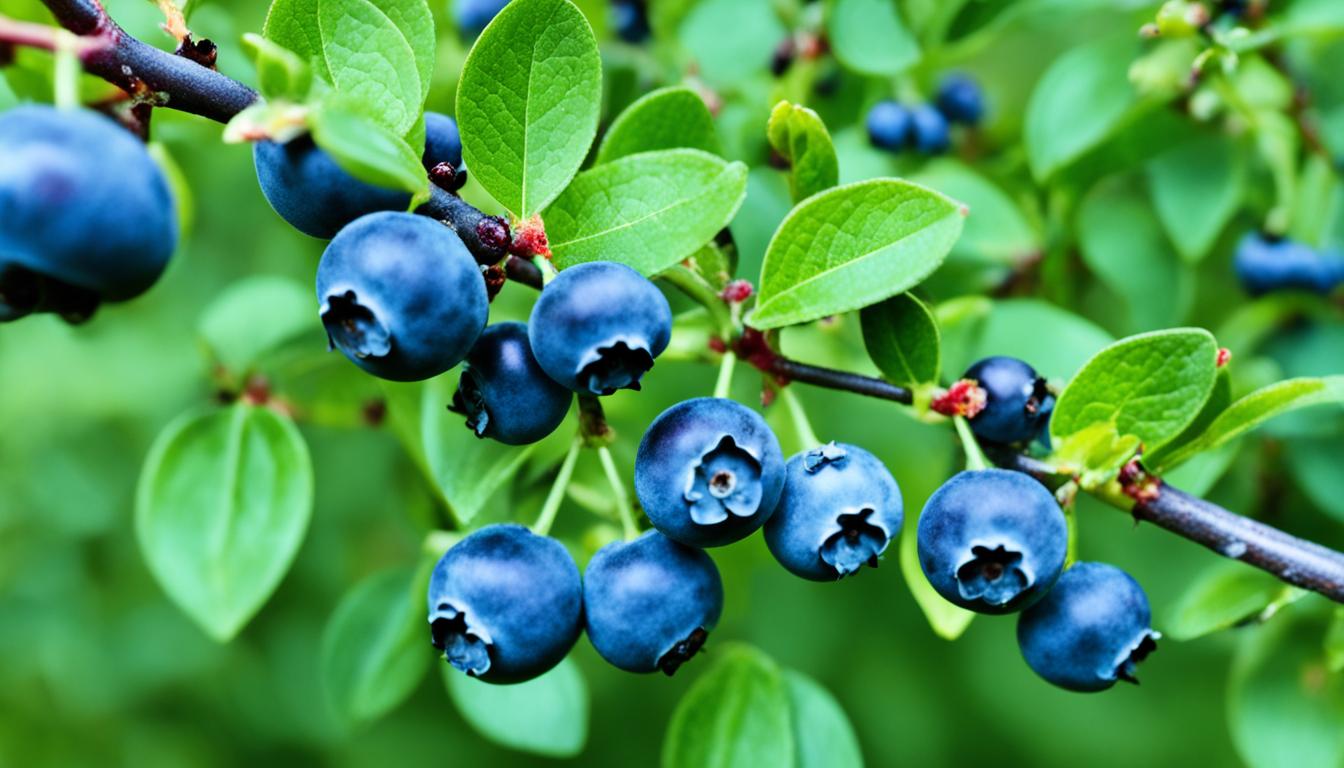Growing blueberries at home can be very rewarding. To get the most berries, consider a few important steps. These include planting different types of blueberries, testing and adjusting the soil for the right acidity, and using mulch. Also, picking the right spot with good drainage is key.
Knowing when and how to prune your bushes can also boost your harvest. By following these expert tips, you can enjoy a lot of blueberries. And you’ll get to taste the sweet, flavorful berries you worked for.
Plant Multiple Blueberry Varieties for Better Pollination
Growing lots of blueberries means planting different types. Some bushes can pollinate themselves, but they do better with another type. Adding various blueberries to your garden means more harvests and more berries each year.
Blueberry Bush Self-Pollination and Cross-Pollination
Blueberries can make fruit on their own, but they do better with another type. This is called cross-pollination. It makes the plants healthier and gives you more berries.
Benefits of Planting Different Blueberry Cultivars
- Extends the blueberry harvest season by including early-, mid-, and late-season ripening varieties
- Provides a wider range of blueberry flavors, sizes, and colors to enjoy
- Improves overall plant health and vigor through increased genetic diversity
- Protects against potential crop losses from late spring freezes or other environmental factors
By mixing different blueberry types, you get a garden that’s full of life and berries. You’ll have lots of juicy, tasty berries every year.
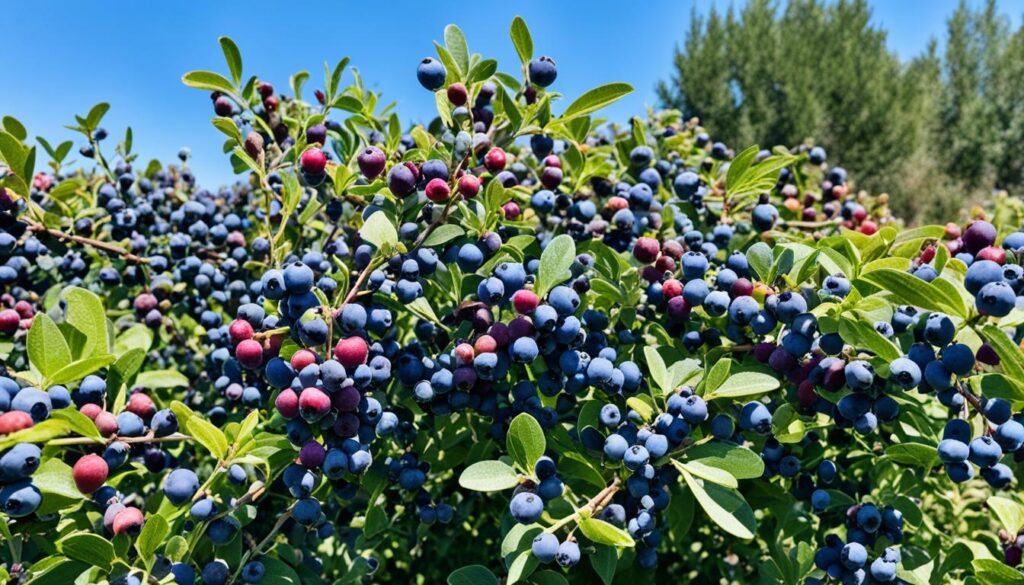
“Planting multiple blueberry varieties together is crucial for optimal fruit production through cross-pollination.”
Test and Amend Soil for Ideal Acidity Level
Blueberry bushes do best in soil with a pH between 4.0 and 5.0. It’s important to test your soil’s pH before planting blueberries. This makes sure the soil is just right for these tasty berries to grow well.
How to Test Soil pH for Blueberry Bushes
You can test your soil’s pH with a home test kit. Just take a soil sample, follow the kit’s instructions, and it will show the pH level. If your soil is too alkaline, you’ll need to make it more acidic.
Adjusting Soil Acidity for Blueberry Plants
To make your soil more acidic, add elemental sulfur or a pH down solution. Use 2 lbs of sulfur per 100 sq ft to lower the pH by 1 unit. Wait at least 2 months before adding more to let the soil adjust.
Another way is to use a raised bed with acidic soil mix or plant blueberries in big containers with acidic potting mix. Adding vinegar to your water can also keep the pH level right.
Keeping your soil’s acidity right is key for healthy, productive blueberry bushes. Test and adjust your soil to get lots of juicy, tasty blueberries.
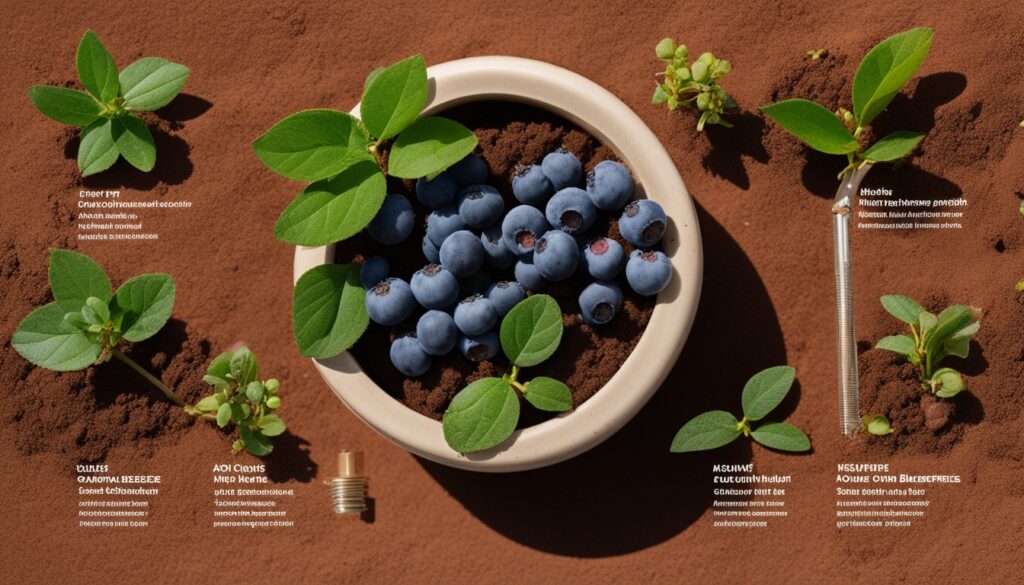
Mulch Blueberry Bushes to Retain Moisture and Prevent Weeds
Looking after your blueberry bushes is key to a great harvest. Putting blueberry mulch around the base is a must. These bushes have shallow roots and dry out easily. Mulching with 2-4 inches of wood chips or pine needles helps keep the soil moist and stops weeds.
Make sure to add more mulch in spring and fall. This keeps your bushes healthy and productive. It’s a simple but important step for your blueberry plants.
For mulch, Douglas fir sawdust is great because it’s acidic, just right for blueberries. Bark mulch is also good, as it keeps the soil acidic too. But avoid peat moss because it can block water from getting to the roots.
Don’t put too much mulch, 3 inches is enough. You’ll need to add more every few years to keep it working well. This keeps the soil moist and stops weeds from growing.
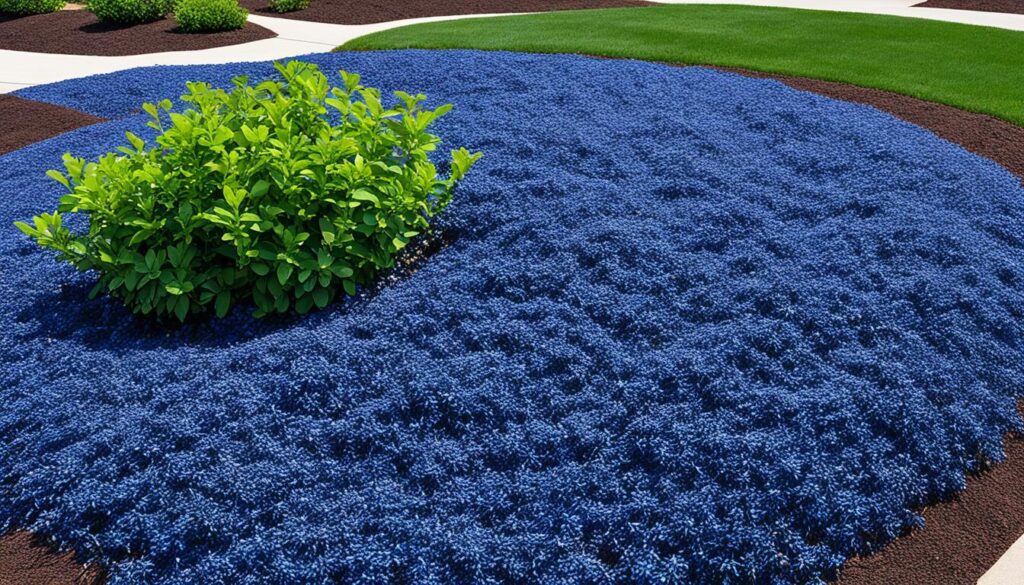
“Mulching blueberry bushes is a simple yet effective way to support their overall health and productivity. By retaining moisture and suppressing weed growth, you’ll be well on your way to a bountiful blueberry harvest.”
Choose a Well-Draining Site for Planting Blueberries
Choosing the right spot for your blueberry bushes is key to their success. These plants need soil that drains well and can’t handle standing water. Make sure to pick a spot with good drainage, either by nature or by adding organic matter to the soil.
Importance of Good Drainage for Blueberry Bushes
Blueberries have shallow roots and don’t like wet feet. If your soil doesn’t drain well, consider a raised bed or containers with acidic soil. This approach prevents the soil from getting too wet and gives your blueberries the best chance to grow.
Watering Requirements for Blueberry Plants
In the first year, blueberry plants need extra water to get at least 1 inch of water each week. After that, they might not need as much water, depending on where you live. Always check the soil moisture and water when needed to keep it moist but not too wet.
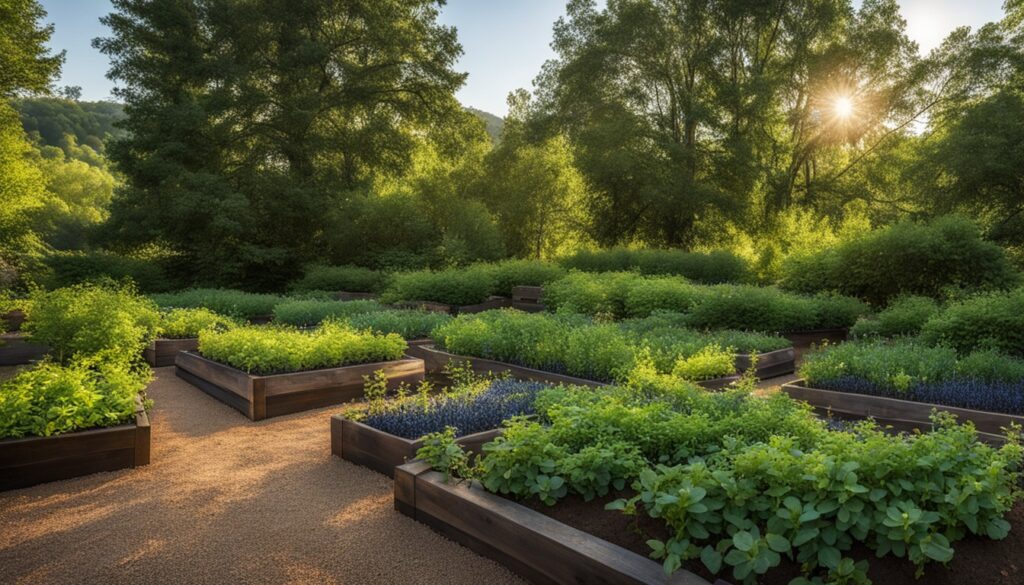
“Blueberries require well-draining soil and cannot tolerate ‘wet feet.’ When selecting a planting site, ensure the area has good drainage, either naturally or by amending the soil with organic matter.”
How to Get More Blueberries on My Bush: Pruning Techniques
Proper pruning is key for keeping your blueberry bushes healthy and productive. The best time to prune is in late winter or early spring, when you can see the fruit buds. Doing it right can really boost your blueberry yield.
When to Prune Blueberry Bushes
The best time to prune blueberry bushes is during their dormant season. This is usually in late winter or early spring, before new growth starts. It’s easier to see which branches to remove when the fruit buds are out. Pruning at this time also helps reduce stress on the plant and keeps it productive.
Steps for Pruning Blueberry Plants
- Begin by cutting off any dead, diseased, or damaged branches. Remove them at the base of the plant.
- Then, thin out the center of the bush to improve air flow. Take out any branches that grow inward or cross each other.
- Trim back any long, leggy branches that don’t produce fruit. Cut them back to where there are several healthy, fruit-bearing buds.
- Try to keep a balanced, open structure with 15-18 canes coming from the plant’s crown.
Regular pruning of your blueberry bushes leads to bigger, tastier berries and more fruit overall. By following these easy steps, you can keep your blueberry plants healthy and productive for many years.
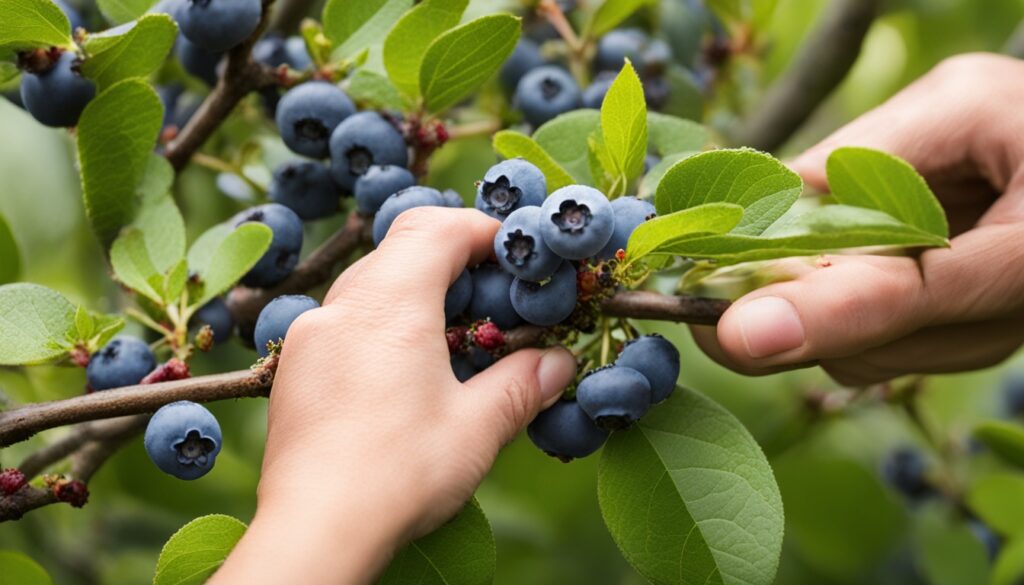
Conclusion
Growing your own blueberries at home is a rewarding experience. It gives you a lot of sweet, flavorful berries. By following expert tips, you can boost your blueberry yield.
Start by planting different blueberry types and testing your soil. Add mulch, pick a spot with good drainage, and prune your bushes. These steps are key for a great blueberry harvest.
Putting in the effort upfront means more blueberries for you. You can enjoy them fresh, freeze them, or even sell them. With the right care, your bushes will do well and give you lots of berries.
Adding growing blueberries at home, homegrown blueberries, and blueberry gardening to your garden is a great idea. It brings more joy and tasty berries to your life.
Start your blueberry growing journey and enjoy the health benefits and culinary fun these fruits offer. Enjoy the berries you’ve grown and feel proud of your hard work and success.
FAQ
How can I get more blueberries on my bush?
To get more blueberries, start by planting different types of blueberry bushes. Make sure the soil is acidic by testing and adding necessary elements. Use mulch and pick a spot that drains well.
Also, prune your bushes at the right time to boost fruit production.
Why is it important to plant multiple blueberry varieties?
Planting several blueberry types is key for better pollination and more berries. Some bushes pollinate themselves, but others need another type to help. This mix means more fruit and a longer picking season.
What is the ideal soil pH for blueberry bushes?
Blueberries love acidic soil with a pH between 4.0 and 5.0. Test your soil first to make sure it’s right. If it’s too alkaline, add things like elemental sulfur to lower the pH.
Or, use acidic potting mix in containers or create a raised bed with acidic soil.
Why is mulching important for blueberry bushes?
Mulching with 2-4 inches of wood chips or pine needles helps keep the soil moist and stops weeds. It’s crucial for keeping your blueberry bushes healthy and productive.
What kind of site should I choose for planting blueberries?
Choose a spot with good drainage for your blueberry bushes. They don’t like wet feet. Improve drainage by adding organic matter to the soil or use raised beds or containers with acidic mix.
When is the best time to prune blueberry bushes?
Prune blueberry bushes in late winter or early spring, when you can see the fruit buds. This cuts out dead or sick branches and helps air move through the bush. It also encourages new canes that bear fruit.
